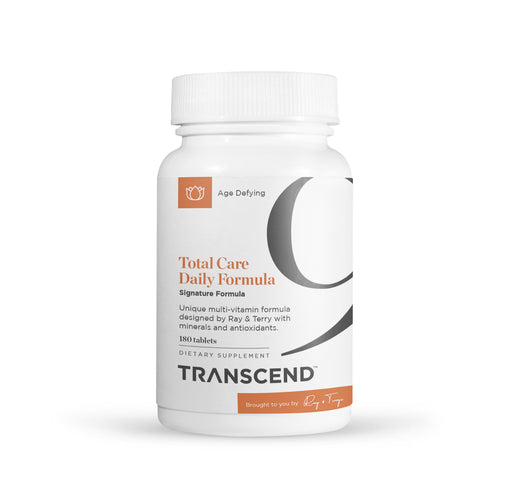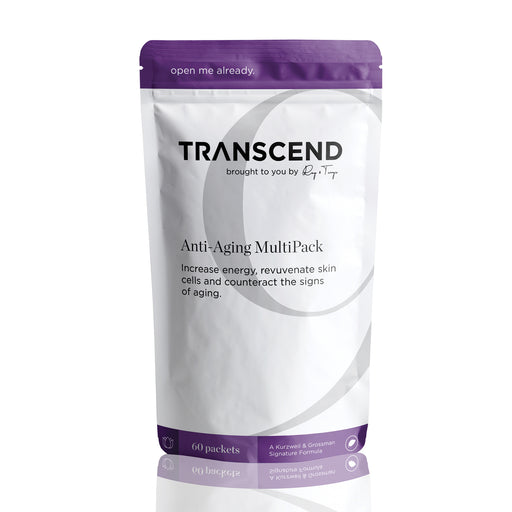
Total Care Daily Formula
A Kurzweil + Grossman Formula Optimal vitamin/mineral foundation Includes three powerful antioxidants Supports overall health and wellness Unique ...
View full details
Our thoughts and actions don’t always align when it comes to our health. We know we should eat a healthy diet, exercise, stay hydrated, get enough sleep, stay connected with friends, find ways to relax, and visit our doctor regularly. Yet, this doesn’t stop us from making unhealthy choices. If you’ve ever had one too many drinks, a stack of late-night brownies, or tiptoed to bed at 2 am after binge watching Netflix, you are not alone. Whether you’re a health expert or a novice, you are human, which means you are susceptible to temptations. In these instances we’re quick to blame ourselves, ignoring larger factors that influence our actions and assuming willpower is the solution. And while willpower may help you achieve short term goals, it is a flawed strategy for living a long and healthy life.
Finding the middle way, from the Buddhist tradition, teaches us to steer clear of extremes and instead, relax into the middle where ease and effort meet. When applied to our health, it is finding a balance between indulgence and deprivation, between perfection and indifference. Instead of grasping for specific outcomes (size x,y,z jeans!), it is stopping to notice what health practices work well for you.
The first step in finding your own middle way, is to acknowledge that everyone, at one time or another, struggles to bridge the gap between what they know and what they do. With this in mind, we have compiled some simple strategies to help you align your knowledge, intentions, and actions to find your path to healthy living.
Practice self-compassion. First and foremost, stop beating yourself up when you fall off the health wagon. You are not a number on a scale or a daily calorie count. Remind yourself that it is not easy to maintain a “perfect” health regimen over a long period of time. Punishing yourself with guilt and negative thinking only increases your chances of going further down the unhealthy rabbit hole. Know that you are not alone and try giving yourself the same compassion that you would give to a friend in a similar situation. [Five ways self-compassion promotes a healthy body image, Psychology Today.]
Find strength in community. There is power in numbers. Connect with people who have similar interests, passions, and desire for healthy living. Have fun, crack jokes, vent, share ideas, and boost each other up when you’re feeling down. Making healthy choices is a daily practice that will grow stronger with support. Try to stay in touch with at least one friend who will check in on you, notice when you don’t show up, and encourage you to keep going. Healthy relationships will help you sustain and enjoy the journey. [Building social connections for a longer, healthier life, TRANSCEND.ME]
Minimize friction. Exercising, eating well, drinking enough water, getting 7+ hours of sleep, finding time to relax… it’s a lot to tackle. When health recommendations are difficult to incorporate into our lives, we are more likely to drop them. So, try to make things easier on yourself. What do you enjoy doing that keeps you physically active? Do that! Don’t join a gym if you don’t like going to the gym. And definitely don’t join one that is out of your way. Choose activities that fit naturally into your life, are close to home, and can be conveniently scheduled around your other commitments. Take a moment to reflect on what’s working and not working in your health regimen; what comes naturally versus what is forced; and then choose the middle path. As you go through this process, set yourself up for success. If you love to take long walks, make sure you have good sneakers and put them on first thing in the morning. If you enjoy specific fruits and vegetables, stock them in your fridge. The less friction between you and your goals, the more likely you will achieve them.
Set timeless goals. Many of us use events to jump start health kicks. We lose weight to fit into a tuxedo for a wedding. We floss more frequently as our dentist appointment approaches. But what happens when that event comes and goes? For many, that’s when we pivot back to our old habits. Fixed goals are helpful in the short-term, but you also need to consider what you want in the long-term. Perhaps you want to feel comfortable and confident in your clothes. Or you want to be strong and healthy so that you can play with your grandkids. Maybe you’d like to stay agile so that you can travel comfortably in later life. Everyone has their own vision of their future. What is yours? Write it down and keep it close.
Have a Beginner’s Mindset. Known as “Shoshin” in Zen Buddhism, a Beginner’s Mindset is the practice of approaching something from a beginner’s perspective no matter how experienced you are. If you keep an open mind and fresh perspective, you become aware of details and nuances that you would otherwise miss. On the other hand, when you think you know everything, you close yourself off to learning. By applying a Beginner’s Mindset to your health, you are more likely to notice the subtleties of what is and isn’t working in your regimen. With this new insight, you can make informed adjustments based on what is actually happening in your life and body. This shift in thinking can make all the difference in finding a healthy path that is right for you. [Five ways to cultivate a beginner’s mindset, Betterup.com.]
Share your story. Tell your friends about your health journey and be honest with the people around you. If you are struggling to find your way, tell someone you trust. Talking about our struggles helps take the shame away. You will be surprised by how many people have similar stories. Treat your victories the same way, even the small ones. Sharing your experiences, both the highs and the lows, will empower you and the people around you to learn from each other and grow. [Listening to shame, Brene Brown, TED 2012]
Learning about these strategies is one thing. Applying them is another. You may already be doing some of these things. If you are, keep it up! If not, start with the strategy that is easiest for you. Practice it for a few days and see how it feels. Then add another. Write them on sticky notes or on your phone to serve as simple cues throughout the day. Let go of perfection and notice what is actually happening in your body and mind in the moment. Pausing and noticing how you feel will bring awareness that can guide you to sustainable health practices that are right for you.

A Kurzweil + Grossman Formula Optimal vitamin/mineral foundation Includes three powerful antioxidants Supports overall health and wellness Unique ...
View full details
A Kurzweil + Grossman Formula Antioxidant and anti-aging protection Increase energy Fight aging Decrease wrinkles Cellular integrity Anti-Aging...
View full details
Improve skin elasticity Cell membrane flexibility Support memory function Healthy brain tissues Phosphatidylcholine (PtC) is a flexible phospho...
View full details
A Kurzweil + Grossman Formula Continued Synergy between Science and Convenience Convenient dosage packets Top anti-aging products Increase energy...
View full details
Leave a comment